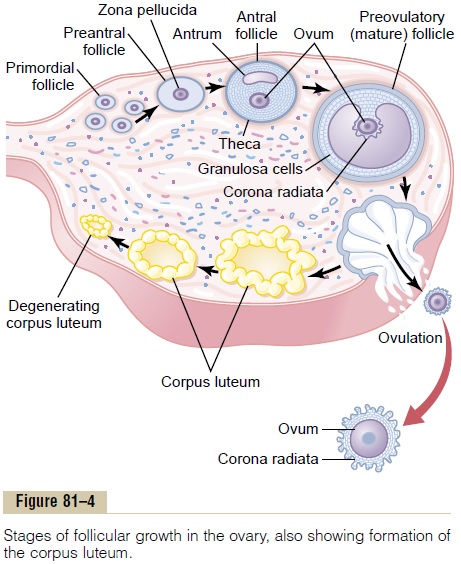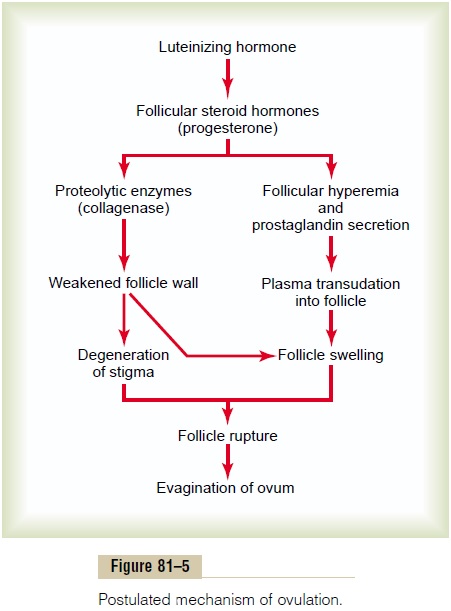Chapter: Medical Physiology: Female Physiology Before Pregnancy and Female Hormones
Ovarian Follicle Growth- ÔÇťFollicularÔÇŁ Phase of the Ovarian Cycle
Ovarian Follicle Growth- ÔÇťFollicularÔÇŁ Phase of the Ovarian Cycle
Figure 81ÔÇô4 shows the progressive stages of follicular growth in the ovaries. When a female child is born, each ovum is surrounded by a single layer of granu-losa cells; the ovum, with this granulosa cell sheath, is called a primordial follicle, as shown in the figure. Throughout childhood, the granulosa cells are believed to provide nourishment for the ovum and to secrete an oocyte maturation-inhibiting factor that keeps the ovum suspended in its primordial state in the prophase stage of meiotic division. Then, after puberty, when FSH and LH from the anterior pituitary gland begin to be secreted in significant quantities, the ovaries, together with some of the follicles within them, begin to grow.

The first stage of follicular growth is moderate enlargement of the ovum itself, which increases in diameter twofold to threefold. Then follows growth of additional layers of granulosa cells in some of the fol-licles; these follicles are known as primary follicles.
Development of Antral and Vesicular Follicles. During thefirst few days of each monthly female sexual cycle, the concentrations of both FSH and LH secreted by the anterior pituitary gland increase slightly to mod-erately, with the increase in FSH slightly greater than that of LH and preceding it by a few days. These hor-mones, especially FSH, cause accelerated growth of 6 to 12 primary follicles each month. The initial effect is rapid proliferation of the granulosa cells, giving rise to many more layers of these cells. In addition, spindle cells derived from the ovary interstitium collect in several layers outside the granulosa cells, giving rise to a second mass of cells called the theca. This is divided into two layers. In the theca interna, the cells take on epithelioid characteristics similar to those of the gran-ulosa cells and develop the ability to secrete additional steroid sex hormones (estrogen and progesterone).
The outer layer, the theca externa, develops into a highly vascular connective tissue capsule that becomes the capsule of the developing follicle.
After the early proliferative phase of growth, lasting for a few days, the mass of granulosa cells secretes a follicular fluid that contains a high concentration ofestrogen, one of the important female sex hormones (discussed later). Accumulation of this fluid causes anantrum to appear within the mass of granulosa cells, asshown in Figure 81ÔÇô4.
The early growth of the primary follicle up to the antral stage is stimulated mainly by FSH alone. Then greatly accelerated growth occurs, leading to still larger follicles called vesicular follicles. This acceler-ated growth is caused by the following: (1) Estrogen is secreted into the follicle and causes the granulosa cells to form increasing numbers of FSH receptors; this causes a positive feedback effect, because it makes the granulosa cells even more sensitive to FSH. (2) The pituitary FSH and the estrogens combine to promote LH receptors on the original granulosa cells, thus allowing LH stimulation to occur in addition to FSH stimulation and creating an even more rapid increase in follicular secretion. (3) The increasing estrogens from the follicle plus the increasing LH from the ante-rior pituitary gland act together to cause proliferation of the follicular thecal cells and increase their secre-tion as well.
Once the antral follicles begin to grow, their growth occurs almost explosively. The ovum itself also enlarges in diameter another threefold to four-fold, giving a total ovum diameter increase up to 10-fold, or a mass increase of 1000-fold. As the follicle enlarges, the ovum itself remains embedded in a mass of granulosa cells located at one pole of the follicle.
Only One Follicle Fully Matures Each Month, and the Remain-der Undergo Atresia. After a week or more of growthÔÇöbut before ovulation occursÔÇöone of the follicles begins to outgrow all the others; the remaining 5 to 11 developing follicles involute (a process calledatresia), and these follicles are said to become atretic.
The cause of the atresia is unknown, but it has been postulated to be the following: The large amounts of estrogen from the most rapidly growing follicle act on the hypothalamus to depress further enhancement of FSH secretion by the anterior pituitary gland, in this way blocking further growth of the less well developed follicles. Therefore, the largest follicle continues to grow because of its intrinsic positive feedback effects, while all the other follicles stop growing and actually involute.
This process of atresia is important, because it nor-mally allows only one of the follicles to grow large enough each month to ovulate; this usually prevents more than one child from developing with each preg-nancy. The single follicle reaches a diameter of 1 to 1.5 centimeters at the time of ovulation and is called the mature follicle.
Ovulation
Ovulation in a woman who has a normal 28-day female sexual cycle occurs 14 days after the onset of menstruation. Shortly before ovulation, the protruding outer wall of the follicle swells rapidly, and a small area in the center of the follicular capsule, called thestigma, protrudes like a nipple. In another 30 minutes or so, fluid begins to ooze from the follicle through the stigma, and about 2 minutes later, the stigma ruptures widely, allowing a more viscous fluid, which has occupied the central portion of the follicle, to evagi-nate outward. This viscous fluid carries with it the ovum surrounded by a mass of several thousand small granulosa cells, called the corona radiata.
Surge of LH Is Necessary for Ovulation. LH is necessaryfor final follicular growth and ovulation. Without this hormone, even when large quantities of FSH are available, the follicle will not progress to the stage of ovulation.
About 2 days before ovulation, the rate of secretion of LH by the anterior pituitary gland increases markedly, rising 6- to 10-fold and peaking about 16 hours before ovulation. FSH also increases about 2-fold to 3-fold at the same time, and the FSH and LH act synergistically to cause rapid swelling of the follicle during the last few days before ovulation. The LH also has a specific effect on the granulosa and theca cells, converting them mainly to progesterone-secreting cells. There-fore, the rate of secretion of estrogen begins to fall about 1 day before ovulation, while increasing amounts of progesterone begin to be secreted.
It is in this environment of (1) rapid growth of the follicle, (2) diminishing estrogen secretion after a pro-longed phase of excessive estrogen secretion, and (3) initiation of secretion of progesterone that ovulation occurs. Without the initial preovulatory surge of LH, ovulation will not take place.
Initiation of Ovulation. Figure 81ÔÇô5 gives a schema for theinitiation of ovulation, showing the role of the large quantity of LH secreted by the anterior pituitary gland. This LH causes rapid secretion of follicular steroid hormones that contain progesterone. Within a few hours, two events occur, both of which are neces-sary for ovulation: (1) The theca externa (the capsule of the follicle) begins to release proteolytic enzymes from lysosomes, and these cause dissolution of the fol-licular capsular wall and consequent weakening of the wall, resulting in further swelling of the entire follicle and degeneration of the stigma. (2) Simultaneously, there is rapid growth of new blood vessels into the fol-licle wall, and at the same time, prostaglandins (local hormones that cause vasodilation) are secreted into the follicular tissues. These two effects cause plasma transudation into the follicle, which contributes to follicle swelling. Finally, the combination of follicle swelling and simultaneous degeneration of the stigma causes follicle rupture, with discharge of the ovum.

Related Topics